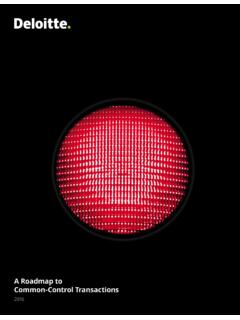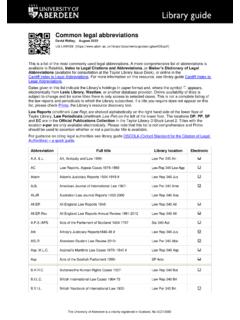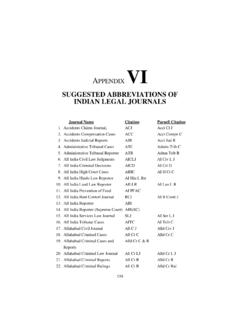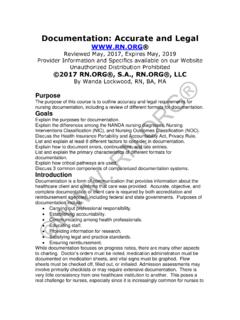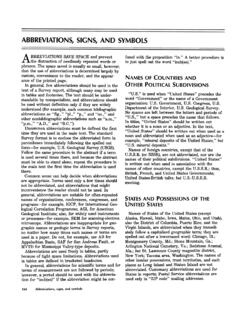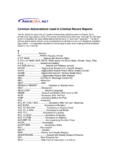Transcription of GUIDE TO CANADIAN LEGAL CITATION - OJEN
1 TABLE OF CONTENTS PART 1 GENERAL RULES: FOOTNOTES/ENDNOTESWhy cite? ..1 Footnotes and Endnotes ..1-2A) STATUTES ..3B) LEGAL CODES ..4C) CASES/REPORTERS ..4-5D) PERIODICALS/JOURNALS ..5-6E) BOOKS ..6-8F) MAGAZINES ..9G) NEWSPAPERS ..9H) ELECTRONIC SOURCES ..10-11 PART 2 GENERAL RULES: BIBLIOGRAPHYG eneral Format ..11 Author s Name Footnotes vs. Bibliography ..11 Hanging Indent ..11 General Format Example ..12 PART 3 GENERAL RULES: IN-TEXT REFERENCESMEMORANDUM ..12 FACTUM ..13-14 FURTHER REFERENCEAPPENDIX: common abbreviations ..15-20 Ontario Justice Education NetworkLEGAL REASONING TOOLGUIDE TO CANADIAN LEGAL 2014 WHY CITE?
2 Proper citing is important. LEGAL matters are one way in which society makes difficult decisions and these decisions can have important consequences for individuals and communities. LEGAL writing is a way of recording how these decisions were made, so that other people can understand them and even revisit and change them in the future. Citations allow others to find the sources that were used so they can consider them on their own and help to clarify which authors are putting forth which ideas or arguments. They also help to show that the writing has been carefully researched and professionally prepared.
3 Careless CITATION detracts from the overall impression of a case brief, memorandum or factum. In Canada, LEGAL writing follows rules that are set out in the CANADIAN GUIDE to Uniform LEGAL CITATION . This reference text is published by the McGill Law Journal, which is affiliated with the Faculty of Law at McGill University in Montreal. Commonly referred to as the McGill GUIDE , it is revised periodically to ensure that the rules it sets out are up-to-date. LEGAL CITATION is complex. The information in this resource is based entirely on the CANADIAN GUIDE to Uniform LEGAL CITATION , 7th ed (Toronto: Carswell, 2010).
4 The sections below address some of the most commonly-used of these rules in language that is accessible to secondary general, there are two different kinds of LEGAL writing. First, there is academic writing, such as scholarly research or textbooks about the law, research reports, professional papers or persuasive essays that deal with matters of law. Second, there are LEGAL documents that are prepared by lawyers and sometimes submitted in the course of researching and making arguments in their cases. The latter part of this resource deals with two examples of these: memoranda and 1: GENERAL RULES: FOOTNOTES/ENDNOTESF ootnotes are the citations for the exact page numbers referred to in a source.
5 They go at the bottom of the page on which that source is used. Endnotes also are citations for the exact page numbers. They are all listed together at the end of a document or a section of a document, just before the bibliography. NOTE: Either can be used, but not both. Footnotes are using the specific CITATION rules, keep these general points in mind: Mark footnotes/endnotes in the written text with numbers like these1 after the punctuation/quotation marks. 2 These numbers are called superscripts . 1 This section at the bottom of the page is called the footnotes. When using footnotes, rather than endnotes, this is where the full references for all the sources used on that page should appear.
6 2 Note that the superscript appears after the period in this Justice Education NetworkCITATION 2014 When citing a source for the first time, provide a complete CITATION for that work in a footnote/endnote. Later references to the same work can be cited using the short forms ibid or supra. Always italicize these and other Latin terms. Ibid - is Latin for in the same place. Use ibid when referring to the same source listed just before. Ibid may be used after supra, (See McGill GUIDE at E-11 to E-12) or even another ibid. For example:1. R v Grant, 2009 SCC 32, [2009] 2 SCR 353 at para 25 [Grant].
7 2. Ibid at para Ibid at para 47. Supra - is Latin for above. Use supra when referring to a source which has already been cited (but not immediately before the current CITATION ). When using supra, refer to the original, complete CITATION , never an ibid or another supra. In the example below supra is used twice, to refer to the sources originally cited in notes 1 and 3:1. R v Grant, 2009 SCC 32, [2009] 2 SCR 353 at para 25 [Grant].2. Ibid at para Sanjeev Anand, A Case for Integration (1994) 25 CR (5th) Grant, supra note 1 at para Anand, supra note 3 at 313. Use short forms - It isn t necessary to repeat information provided in the written text or in a CITATION .
8 If the name of the case being cited is used in the text of the paper, don t repeat the name in the CITATION . Just keep the rest of the information. When using supra, as in the example above, use a short form for the source. Notice how note 4 uses the short form Grant to refer to the original R v Grant. In note 5, the short form Anand (the author s last name) has replaced Sanjeev Anand. The short form for a source ( [Grant] should be written at the end of the original CITATION in [brackets] (see note 1, in the examples above). Pinpoint citations - Footnotes and endnotes should identify the precise page or paragraph number referred to from the source.)
9 The format for precise citations is shown in notes 1, 2, and 4 in the example at the top of this page. An example of how to show the precise page number is shown in note 5. Note that the familiar terms page and p. are not used to pinpoint a page reference, but para is used to indicate a specific paragraph, usually in a LEGAL decision. Abbreviate chapter to c. Abbreviate section to s. and sections to ss. in the footnotes or endnotes. In the text, write these terms out in full the first time they are used, but use the same abbreviations in all later instances. For Quebec codes, abbreviate article and articles as art and arts, respectively.
10 Do not abbreviate preamble or schedule. When referring to more than one section of a source, separate consecutive sections with a hyphen (1-2-3) and non-consecutive ones with a comma (4,7,9).Ontario Justice Education NetworkCITATION 2014 ChapterJurisdiction and Year Section and (Subsection)Registered Human Resources Professionals Act, 2013, SO 2013, c 6, s 1(3).TitleSPECIFIC RULES: FOOTNOTES/ENDNOTESA) STATUTES A. CITING STATUTES FROM PRINT RESOURCES Statutes means the laws of a region. Examples of CANADIAN statutes include the Copyright Act, Criminal Code, Youth Criminal Justice Act and Access to Information Act.


